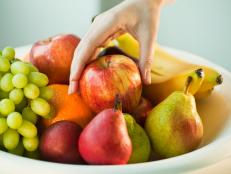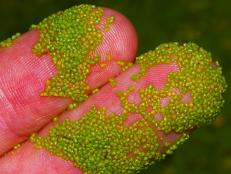In Japan, People Will Pay Big Bucks for Ultra-Fancy Fruit

Would you pay $27,000 for a couple of melons (if you had $27,000 to throw around)? In Japan, that happens.
Last May, a deep-pocketed bidder shelled out a record-setting 3 million yen ($27,240) for two premium cantaloupe melons in an auction in the Sapporo Central Wholesale Market. And that bidder is not alone in blowing big bucks on primo produce.
It’s customary in Japan to present pretty, pricey, beautifully wrapped fruit to people as a symbol of gratitude, love or respect, a way to say thanks and show that you care. And so a business has grown around the growing and selling of fancy, fancy fruit.
At Sembikiya, which bills itself as Japan’s oldest fruit shop (it opened its first store more than 180 years ago, in 1834), fruit is presented in glass cases, like jewels, CNN recently noted.
Shoppers at Sembikiya, which has several locations, can browse through watermelons grown in various shapes (hearts, cubes, pyramids), for which they can expect to pay about $100 apiece, or ping-pong-ball-size "Ruby Roman" grapes, which can go for $880 per bunch. That’s a bargain compared to the batch of record-setting Ruby Romans sold to a bidder last July for 1.1 million yen ($10,900) at a wholesale market in Kanazawa, Ishikawa Prefecture. (Honestly, these are wholesale prices?)
The price itself conveys status and the giver’s regard for the receiver and can make the fruit taste “more delicious in a subtle way,” Cecilia Smith Fujishima, a comparative culture lecturer at Tokyo’s Shirayuri University, observed to CNN.
It also reflects the care with which the fruit may be grown. Take, for instance, this description of Sembikiya’s “famous” muskmelon (aka “the king of fruits), posted on the fruit store’s website.
In order to thoroughly manage the water in the fruit, each melon is suspended away from the ground and the air temperature is controlled year-round by heaters during the winter and air conditioners during the summer.
Please enjoy the “look of the spherical shape with the beautiful net” around it, which was created by a special “massage” called ball wiping individually performed on each melon, as well as the “scent of musk” and the “melting sweetness and rich taste” of our muskmelons.
Oh, my.























































